Did you know you can grow fresh, fragrant herbs all year, even without a big outdoor garden? With some knowledge and green thumbs, you can make a thriving indoor herb garden. This garden will make your cooking better and fill your home with nature’s scent. We’ll look at the top 5 quick-growing herbs perfect for your indoor space. You’ll get tips on how to grow, care for, and use them in cooking.
Key Takeaways
- Many herb varieties can thrive indoors, allowing you to enjoy homegrown flavors year-round.
- Growing quick-growing herbs like basil, chives, parsley, dill, and thyme can be a cost-effective way to elevate your cooking.
- Herbs can be grown in containers or on a sunny windowsill, making them ideal for small spaces and urban gardens.
- Cultivating an indoor herb garden provides the convenience of fresh, aromatic herbs at your fingertips.
- With the right growing conditions, you can enjoy a bountiful harvest of these low-maintenance, quick-growing herbs.
Introduction to Growing Herbs Indoors
Growing an indoor herb garden is rewarding for home cooks and green thumbs. It’s great if you have little outdoor space or want fresh herbs all year. Indoor gardening brings many benefits. You get to enjoy the smells and advantages of kitchen herb gardening.
Benefits of an Indoor Herb Garden
An indoor herb garden has many advantages for households. Key benefits include:
- Always having fresh, flavorful herbs for cooking and decorating
- Saving money by not buying herbs at the store
- Growing herbs all year, even in cold places
- Boosting food security and self-sufficiency in your kitchen
- Enjoying a hobby that helps you relax and be mindful
Considerations for Indoor Gardening
There are important things to think about with an indoor herb garden. These include:
- Sunlight needs: Many herbs love lots of sunlight. Make sure your indoor spot gets enough natural or artificial light.
- Temperature and humidity: Herbs like certain temperatures and humidity levels. You might need to adjust your indoor space for them.
- Soil and drainage: Choosing the right soil and making sure it drains well is key for your herbs to stay healthy.
- Pest control: Indoor gardens can attract pests. Watch out for them and use safe ways to keep them away.
Knowing the benefits and considerations of indoor herb gardening helps you grow a great indoor herb garden. It makes cooking better and brings gardening joy into your home.
Quick-growing herbs for indoors
Want to start your own indoor herb garden but don’t know which plants will do well? You’re in the right place! Some herbs are perfect for indoor gardens, growing fast, producing a lot, and needing little care. Find out the best herbs for indoor growing to fill your kitchen with fresh flavors quickly.
- Rosemary: This fragrant herb excels indoors, doing great in bright, sunny spots and needing little water.
- Mint: Mint grows quickly, filling your space with its unique scent. But, keep it in check to prevent it from spreading too much.
- Thyme: Thyme is an easy indoor herb that doesn’t require much attention. It adds strong flavor and can handle less light.
- Parsley: This herb is a low-maintenance indoor plant that gives you a lot of leaves when grown indoors.
- Chives: Chives are tough and do well in containers, making them ideal for easy indoor herb gardens.
| Herb | Light Requirements | Watering Needs | Maintenance Level |
|---|---|---|---|
| Rosemary | Bright, direct sunlight | Moderate | Low |
| Mint | Partial shade to full sun | Moderate to high | Moderate |
| Thyme | Partial shade to full sun | Low to moderate | Low |
| Parsley | Partial shade to full sun | Moderate | Low |
| Chives | Partial shade to full sun | Moderate | Low |
With these fastest growing herbs indoors, you’re set to create a vibrant indoor herb garden. This will improve your cooking and bring fresh flavors right to your kitchen.
Basil: A Versatile Culinary Delight
Basil is a favorite herb known for its bright, aromatic flavors. It’s essential in the kitchen, whether you’re making pesto or adding a fresh touch to tomato dishes. Growing basil indoors means you always have this gem ready to use.
Growing Basil from Seeds and Cuttings
Starting basil plants from seeds or cuttings is easy. For growing basil from seeds, plant them in well-draining soil and keep it moist until they germinate. This can take 7-14 days. After the seedlings appear, thin them to let them grow well. If propagating basil from cuttings, cut a 4-6 inch stem, remove the lower leaves, and put it in a jar of water. Roots will form in a few weeks, and you can then move the cutting to soil.
Sunlight and Temperature Requirements
Basil loves warm, sunny spots, making it perfect for indoor growing. Try to give your basil at least 6 hours of direct sunlight daily. If needed, use a grow light. Keep the temperature steady between 70-85°F (21-29°C) for best growth and flavor. Don’t let your basil get cold or have sudden temperature changes, as this can harm the plants.
Basil is the essential herb for adding a burst of fresh flavor to countless dishes. With the right growing conditions, you can enjoy a bountiful harvest of this culinary gem right in your own home.”
Chives: The Hardy Onion Cousin
Chives are a great choice for growing chives indoors. They are the onion’s cousin and add a unique taste to many dishes. Chives as indoor herbs are easy to care for and can grow well in different indoor settings.
Chives are very tough and can handle various light and temperature changes. This makes them perfect for indoor chive cultivation. Even if you’re new to gardening, you can easily grow chives indoors.
- Chives are a perennial herb, meaning they will regrow year after year with proper care.
- They require minimal maintenance, making them an easy indoor chives option for busy home cooks.
- Chives add a subtle onion-like flavor to a wide range of dishes, from salads and soups to omelets and baked potatoes.
Adding chives to your indoor herb garden is a great idea for both new and experienced gardeners. They are chives as indoor herbs are versatile and easy to grow. They are a must-have for anyone who loves indoor gardening.
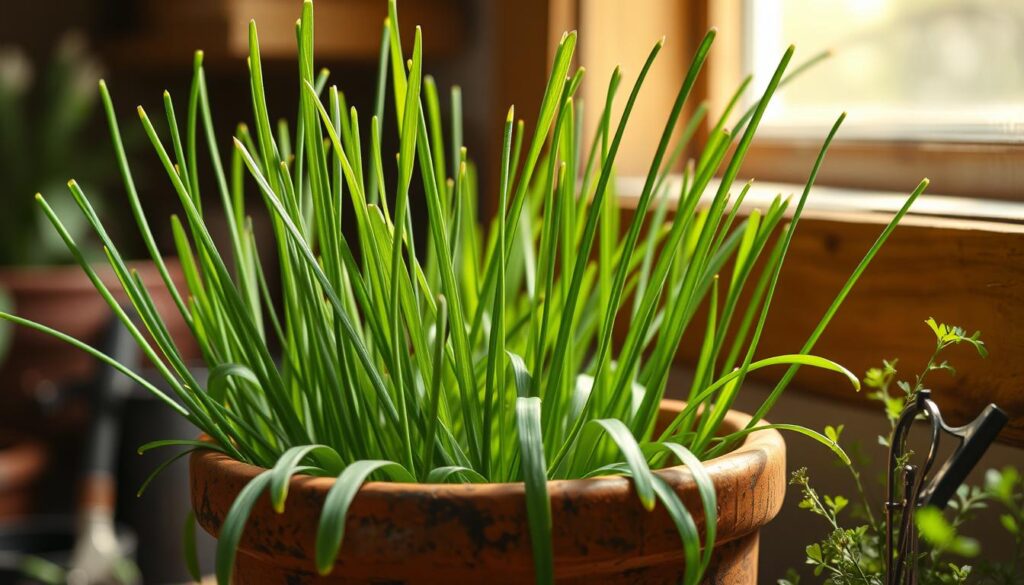
“Chives are a wonderful addition to any indoor herb garden, providing a burst of flavor and a touch of natural beauty to your culinary creations.”
Parsley: A Nutritious and Flavorful Addition
Parsley is a versatile and aromatic herb that’s great for any indoor garden. It’s full of nutrients and adds fresh flavor to many dishes. Growing parsley indoors is easy and rewarding for cooks of all levels.
Growing Parsley Indoors
Indoor parsley cultivation is simple. It likes well-draining soil and needs consistent moisture. Make sure it gets 6-8 hours of sunlight a day. A sunny windowsill or grow light works well.
Start by sowing parsley seeds or buying young plants from a nursery. Space them 6-8 inches apart for growth and air flow. Water and fertilize them regularly for a steady harvest.
Harvesting and Using Parsley
Harvest parsley leaves as you need them, letting the plant keep growing. Harvest in the morning for the best flavor and freshness.
Add fresh parsley to soups, salads, pasta, and more. Its bright, slightly peppery taste complements many ingredients. Try using parsley in new ways to improve your cooking.
Parsley is a top choice for home gardeners because of its nutrition and indoor growth. Follow these tips to enjoy growing parsley indoors and add it to your daily meals.
Dill: The Delightful Feathery Herb
Dill, known for its feathery fronds and warm flavor, is great for growing dill indoors. It’s easy to grow at home, letting you enjoy the fresh taste of indoor dill cultivation in your cooking.
Planting and Caring for Dill
To grow dill indoors, begin by planting seeds in well-draining soil. Make sure your indoor garden gets at least 6 hours of sunlight daily. Dill needs regular watering, keeping the soil moist but not too wet. Dill grows quickly, so you’ll soon have fresh dill for your recipes.
- Sow dill seeds about 1/4 inch deep and 6 inches apart.
- Provide your dill plants with at least 6 hours of direct sunlight each day.
- Water the soil regularly, keeping it moist but not saturated.
- Harvest the feathery fronds when they reach 6-8 inches in height.
Growing dill indoors is easy and adds a delightful flavor to your meals. Enjoy the fresh taste of dill in salads, soups, and more, all from your indoor garden.
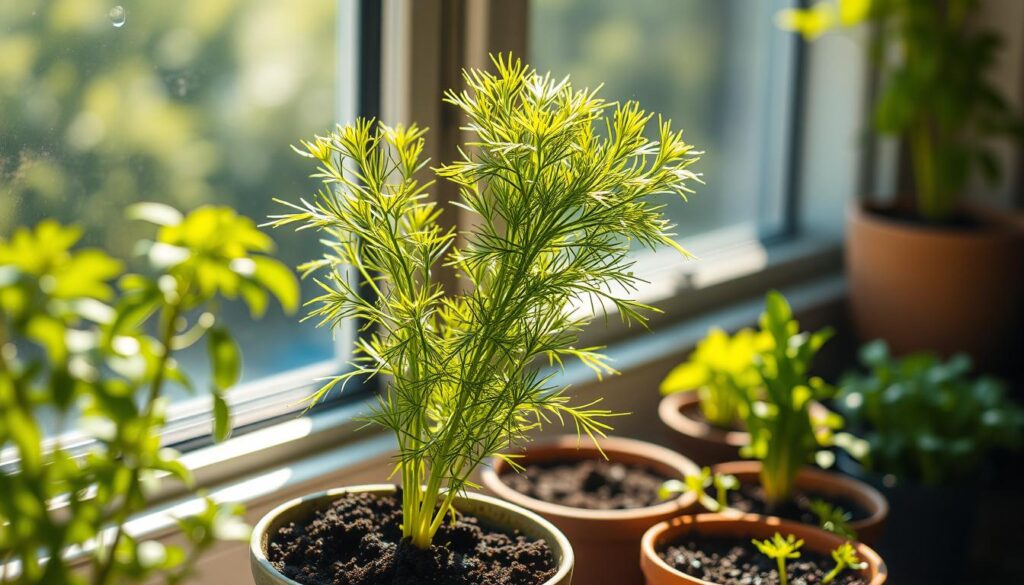
Thyme: The Fragrant Woody Herb
Thyme is a great herb for indoor gardens, adding a rich, piney flavor to many dishes. If you want to grow thyme indoors or learn about indoor thyme cultivation, it’s a top pick. It’s perfect for adding flavor to your cooking.
Propagating and Growing Thyme
Starting thyme is easy, using seeds or cuttings. For growing thyme indoors, make sure it gets plenty of sunlight. Place it in a bright window or under grow lights.
For the best thyme care indoors, keep the soil dry and well-drained. Thyme likes soil that’s a bit acidic. Regularly trim and pick the fresh thyme leaves to keep the plant healthy and full.
“Thyme is a versatile herb that can transform a dish with its bold, earthy flavor. Incorporating fresh thyme into your recipes is a surefire way to add depth and complexity to your culinary creations.”
With the right care, you can have growing thyme indoors and using fresh thyme all year. It brings fragrance and flavor to your meals.
Conclusion
Growing a thriving indoor herb garden is a great way to make your cooking better. It lets you enjoy the fresh, homegrown flavors. By focusing on the top 5 quick-growing herbs – basil, chives, parsley, dill, and thyme – you can turn your kitchen into a vibrant, fragrant place. With the right growing conditions and care, you can get a lot of these versatile herbs. They add depth and dimension to your cooking.
If you’re a home cook or new to indoor gardening, learning to grow these herbs can change the game. From the aromatic basil to the hardy chives, each herb brings its own flavor and nutritional benefits. This lets you make your dishes better and improve your cooking experience.
Starting an indoor herb garden means you’ll always have fresh herbs on hand. It also gives you the joy of growing and harvesting your own produce. Let your culinary adventures grow with the joy of these flavorful herbs.
FAQ
What are the benefits of growing an indoor herb garden?
What are the key considerations for cultivating herbs indoors?
Which herbs are best suited for indoor cultivation?
How do I grow basil indoors?
Why are chives a great choice for an indoor herb garden?
How can I successfully grow parsley indoors?
What are the steps for growing dill indoors?
How do I grow thyme indoors?
Source Links
- 20 herbs & veggies that you can grow inside – https://www.yardbarker.com/lifestyle/articles/20_herbs_veggies_that_you_can_grow_inside/s1__34194290
- 5 Easy Herbs to Grow At Home – https://stevensvillegardengallery.com/blogs/blogs/5-easy-herbs-to-grow-at-home-1?srsltid=AfmBOoopMIzaSaTEgxcLtmJlMFdTFFLtR7srWaKUM11URAllg_EyVrSS
- How to Successfully Grow Your Kitchen Herb Garden – https://www.tasteofhome.com/collection/top-10-herbs-for-your-kitchen-garden/


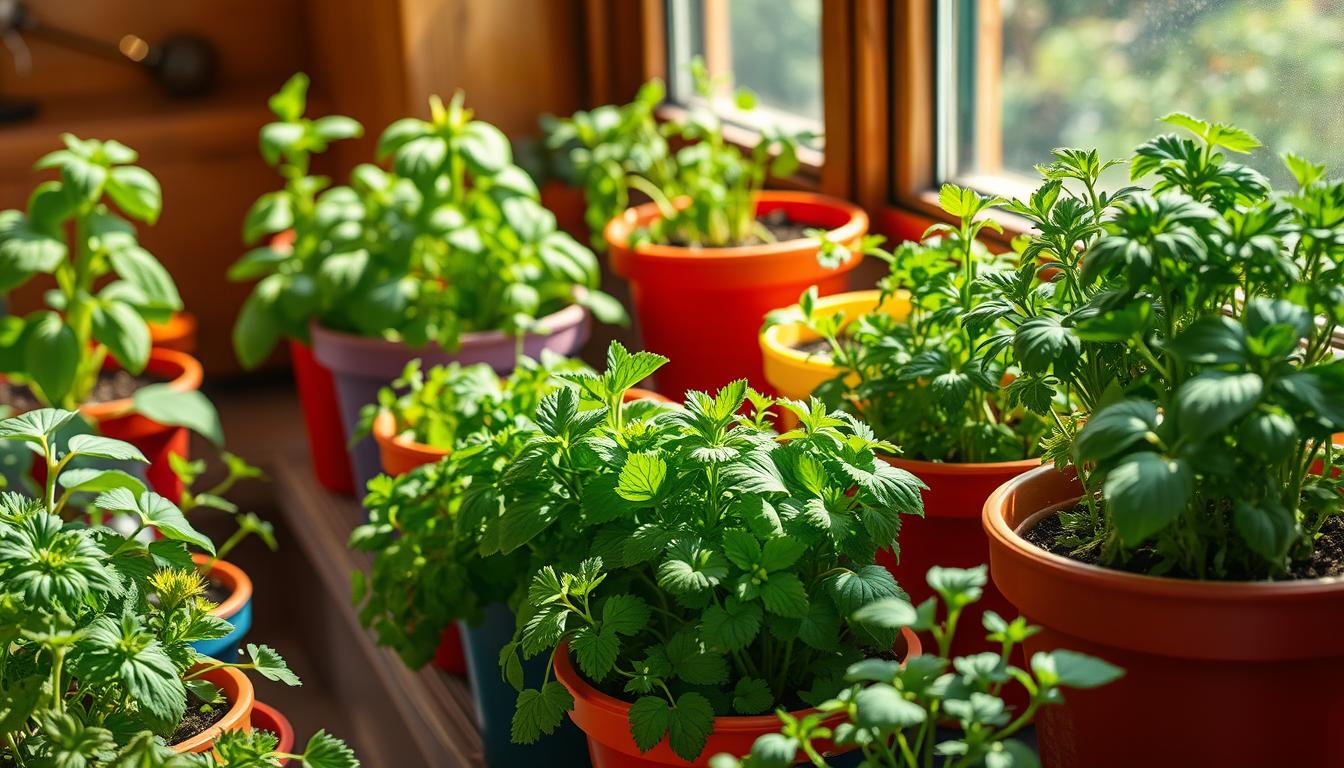
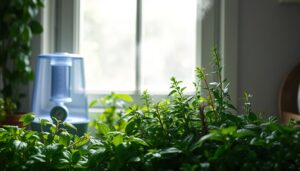
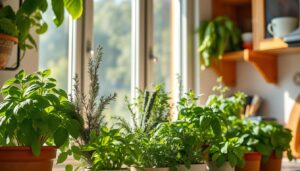
Pingback: The Ultimate Guide to Growing Herbs Indoors: Tips, Tricks, and Best Practices